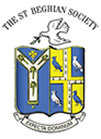|
 |
The Old St Beghian | |
| July 2021 | |||
Ivor Nicholas (SH 44-48) has submitted some reminiscences.
“I recently noticed that a custom-built contraption, designed and home-made for long-distance photography, is included in an exhibition scheduled for July 2021 (Covid permitting) at Whitehaven’s Beacon Museum. This prompted the following memories.
In 1948 I set up as a freelance press photographer in Cumbria when I left school. My father, Joseph W. Nicholas, had edited the West Cumberland Times during the war years, while my mother, Ethel, who was originally from Egremont, answered the telephone there. I was encouraged by my early successes, particularly with the large number of daily and evening newspapers and magazines taking my work and with Agencies ensuring their general circulation in the country at that time. There could not have been better encouragement for ‘doing one’s own thing’ to earn a living. Within two years I had pictures published both in this country and abroad. It was, for example, a period when rugby league was flourishing both at Workington and Whitehaven; Workington Town made the third division of the football league, and local clubs began to appear in the early rounds of the FA Cup. All this enabled me to contribute regularly to major Monday morning dailies such as the Mail, the Express, the Herald, News Chronicle and the Manchester Guardian, among others, as well as evening newspapers.
More ‘locally’, among possible recollections of OSBs, and taking me back to the exhibit at the Beacon, is the camera used to photograph house and team groups at St Bees School. Alf Scott, the school’s photographer, worked with a similar camera to the one in the exhibition from his photographic business in Roper Street, Whitehaven. This quarter-plate reflex model was the pride of Alf’s business. After arranging a group and setting up the tripod and camera, he hid himself under a large black blanket. After what seemed an age, he emerged to take command of proceedings. Placing his hat over the lens, he would take a double-sided pre-loaded glass plate holder from the left pocket of his jacket, snap it into the focused plate frame holder, and after exposing this by removing the cover slide, quickly removing and replacing his hat, he would replace the cover slide and transfer the now exposed double dark slide into his right hand pocket. This procedure was repeated for each exposure. The use of a double-sided holder allowed a second repeat shot for each different group in case someone, in the unlikely event, blinked! Prints of excellent quality were later displayed around the school and orders taken from boys with the cost added to the bill at the end of term.
The School House pictures in the 1940s were of a superb quality considering the rationing of materials and equipment then in force. ‘Rip Van Winkle’ was a name given to the photographer by the boys. Perhaps it was something to do with the long delay involved in taking the photograph!”
Home
The St Beghian Society
St Bees School,
St Bees, Cumbria, CA27 0DS.
Tel: (01946) 828093 Email: osb@stbeesschool.co.uk
Web: www.st-beghian-society.co.uk
![]()